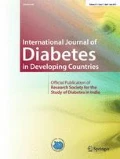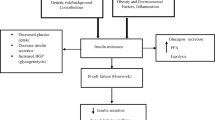Abstract
Paraoxonase-1 (PON1) is involved in prevention of lipid peroxidation and has been associated with diseases characterized by high oxidative stress, such as cardiovascular disease and diabetes. It has been studied as a potential candidate gene for diabetes risk, but direct evidence from genetic association studies remains inconclusive. We performed an analysis in order to investigate the association between three PON1 polymorphisms (Q192R, L55M, and −108C>T) with type 2 diabetes mellitus (T2DM) in south Iranian population. A total of 340 individuals (171 documented T2DM patients and 169 healthy controls) were examined in this study. After DNA isolation and PCR-RFLP, the products were analyzed for L55M and Q192R polymorphisms in coding region and for −108C>T in promotor sequence of PON1. Statistical analysis showed that all genotypes of Q192R and −108C>T polymorphisms were not associated with diabetes (P > 0.05). However, in PON1 55 gene polymorphism, the allelic frequency of methionine (M) was significantly higher in T2DM patients compared to controls (37 vs. 28%, P < 0.05). In addition, a strong association was found between the LM+MM group and diabetes (P = 0.006). The results of the haplotype analysis for the combinations of the three polymorphisms in patients were shown that the haplotype L-T-R frequency was significantly lower in patients as compared to the controls with odds ratio of 0.28 (OR = 0.28, 95% CI 0.13–0.60, P = 0.0004). The most frequent haplotype in two patient and control groups was L-C-Q (31 and 30.2%, respectively). Met allele of PON1 55 gene polymorphism is an independent risk factor for T2DM and the L-T-R may represent as a protective haplotype in south Iranian population. Our results showed that the frequencies of polymorphisms of PON1 in the south Iranian population differ to some of those observed in other ethnic groups and provide useful data for epidemiological studies.

Similar content being viewed by others
References
World Health Organization. Diabetes mellitus fact sheet no. 312. Geneva: WHO; 2006.
Powers AC. Diabetes mellitus. In: Braud E (ed) Harrison’s principles of internal medicine, 16th edn. McGraw Hill Medical Publishing Division; 2005.
Whiting DR, Guariguata L, Weil C. IDF diabetes atlas: global estimates of the prevalence of diabetes for 2011 and 2030. Diabetes Res Clin Pract. 2011;94(3):311–21.
Opara EC. Oxidative stress, micronutrients, diabetes mellitus and its complications. J R Soc Promot Heal. 2002;122:28–34.
Friedlyand LE, Philipson LH. Oxidative reactive species in cell injury: mechanism in diabetes mellitus and therapeutic approaches. Ann N Y Acad Sci. 2006;1066:136–51.
West LC. Radicals and oxidative stress in diabetes. Diabet Med. 2000;17:171–80.
Robertson RP, Harmon J, Tran PO. Glucose toxicity in beta-cells: type 2 diabetes, good radicals gone bad, and the glutathione connection. Diabetes. 2003;52:581–7.
Niedowicz DM, Daleke DL. The role of oxidative stress in diabetic complications. Cell Biochem Biophys. 2005;43:289–330.
Camps J, Marsillach J, Joven J. The paraoxonases: role in human diseases and methodological difficulties in measurement. Crit Rev Clin Lab Sci. 2009;1;46(2):83–106.
Tomás M, Latorre G, Sentí M, Marrugat J. The antioxidant function of high density lipoproteins: a new paradigm in atherosclerosis. Rev Esp Cardiol. 2004;57(6):557–69.
Kinumi T, Ogawa Y, Kimata J, Saito Y, Yoshida Y, Niki E. Proteomic characterization of oxidative dysfunction in human umbilical vein endothelial cells (HUVEC) induced by exposure to oxidized LDL. Free Radic Res. 2005;39(12):1335–44.
Mackness MI, Durrington PN, Mackness B. The role of paraoxonase 1 activity in cardiovascular disease: potential for therapeutic intervention. Am J Cardiovasc Drugs. 2004;4(4):211–7.
Karabina SA, Lehner AN, Frank E, Parthasarathy S, Santanam N. Oxidative inactivation of paraoxonase-implications in diabetes mellitus and atherosclerosis. Biochim Biophys Acta. 2005;1725(2):213–21.
Kim DS, Marsillach J, Furlong CE, Jarvik GP. Pharmacogenetics of paraoxonase activity: elucidating the role of high-density lipoprotein in disease. Pharmacogenomics. 2013;14(12):1495–515.
Liu YL, Yang J, Zheng J, Liu DW, Liu T, Wang JM, et al. Paraoxonase 1 polymorphisms L55M and Q192R were not risk factors for Parkinson’s disease: a HuGE review and meta-analysis. Gene. 2012;15;501(2):188–92.
Xie S, Li J, Chen Y, Wang C, Zhang H, Mo D. Sequence identification, chromosomal mapping and tissue specific expression of the porcine paraoxonase 1 (PON1) gene. Mol Biol Rep. 2010;37(3):1347–53.
Gross ER, La Disa Jr JF, Weihrauch D, Olson LE, Kress TT, Hettrick DA, et al. Reactive oxygen species modulate coronary wall shear stress and endothelial function during hyperglycemia. Am J Physiol Heart Circ Physiol. 2003;284(5):H1552–9.
Kalousová M, Zima T, Tesar V, Dusilová-Sulková S, Skrha J. Advanced glycoxidation end products in chronic diseases-clinical chemistry and genetic background. Mutat Res. 2005;579(1–2):37–46.
Maritim AC, Sanders RA, Watkins 3rd JB. Diabetes, oxidative stress, and antioxidants: a review. J Biochem Mol Toxicol. 2003;17(1):24–38.
Draganov DI, La Du BN. Pharmacogenetics of paraoxonases: a brief review. Naunyn Schmiedeberg's Arch Pharmacol. 2004;369(1):78–88.
Li B, Sedlacek M, Manoharan I, Boopathy R, Duysen EG, Masson P, Lockridge O. Butyrylcholinesterase, paraoxonase, and albumin esterase, but not carboxylesterase, are present in human plasma. Biochem Pharmacol. 2005;70(11):1673–84.
Ceron JJ, Tecles F, Tvarijonaviciute A. Serum paraoxonase 1 (PON1) measurement: an update. BMC Veterinary Res. 2014;10:74.
Furlong CE, Richter RJ, Li WF, Brophy VH, Carlson C, Rieder M, et al. The functional consequences of polymorphisms in the human PON1 gene. InThe paraoxonases: their role in disease development and xenobiotic metabolism. Netherlands: Springer; 2008.
Richter RJ, Jarvik GP, Furlong CE. Paraoxonase 1 status as a risk factor for disease or exposure. Adv Exp Med Biol. 2010;660:29–35.
Mackness B, Mackness M, Aviram M, Paragh G. The paraoxonases: their role in disease development and xenobiotic metabolism. Springer Science & Business Media; 2007.
Aviram M, Hardak E, Vaya J, Mahmood S, Milo S, Hoffman A, et al. Human serum paraoxonases (PON1) Q and R selectively decrease lipid peroxides in human coronary and carotid atherosclerotic lesions: PON1 esterase and peroxidase-like activities. Circulation. 2000;101(21):2510–7.
Brophy VH, Hastings MD, Clendenning JB, Richter RJ, Jarvik GP, Furlong CE. Polymorphisms in the human paraoxonase (PON1) promoter. Pharmacogenetics. 2001;11(1):77–84.
Leviev I, James RW. Promoter polymorphisms of human paraoxonase PON1 gene and serum paraoxonase activities and concentrations. Arterioscler Thromb Vasc Biol. 2000;20(2):516–21.
Voetsch B, Benke KS, Panhuysen CI, Damasceno BP, Loscalzo J. The combined effect of paraoxonase promoter and coding region polymorphisms on the risk of arterial ischemic stroke among young adults. Arch Neurol. 2004;61(3):351–6.
James RW, Leviev I, Ruiz J, Passa P, Froguel P, Garin MC. Promoter polymorphism T(-107)C of the paraoxonase PON1 gene is a risk factor for coronary heart disease in type 2 diabetic patients. Diabetes. 2000;49(8):1390–3.
Grdic M, Barisic K, Rumora L. Genetic frequencies of paraoxonase 1 gene polymorphisms in Croatian population. Croat Chem Acta. 2008;81:105–11.
Moasser E, Azarpira N, Shirazi B, Saadat M, Geramizadeh B. Genetic polymorphisms of glutathione-s-transferase M1 and T1 genes with risk of diabetic retinopathy in Iranian population. Iran J Basic Med Sci. 2014;17(5):351–6.
Moasser E, Kazemi-Nezhad SR, Saadat M, Azarpira N. Study of the association between glutathione S-transferase (GSTM1, GSTT1, GSTP1) polymorphisms with type II diabetes mellitus in southern of Iran. Mol Biol Rep. 2012;39(12):10187–92.
Bhattacharyya T, Nicholls SJ, Topol EJ, Zhang R, Yang X, Schmitt D, et al. Relationship of paraoxonase 1 (PON1) gene polymorphisms and functional activity with systemic oxidative stress and cardiovascular risk. JAMA. 2008;299(11):1265–76.
Kordi-Tamandani DM, Hashemi M, Sharifi N, Kaykhaei MA, Torkamanzehi A. Association between paraoxonase-1 gene polymorphisms and risk of metabolic syndrome. Mol Biol Rep. 2012;39(2):937–43.
Mackness B, Mackness MI, Arrol S, Turkie W, Julier K, Abuasha B, et al. Serum paraoxonase (PON1) 55 and 192 polymorphism and paraoxonase activity and concentration in non-insulin dependent diabetes mellitus. Atherosclerosis. 1998;4;139(2):341–9.
Agachan B, Yilmaz H, Karaali Z, Isbir T. Paraoxonase 55 and 192 polymorphism and its relationship to serum paraoxonase activity and serum lipids in Turkish patients with non-insulin dependent diabetes mellitus. Cell Biochem Funct. 2004;22:163–8.
Gupta N, Binukumar BK, Singh S, Sunkaria A, Kandimalla R, Bhansali A, et al. Serum paraoxonase-1 (PON1) activities (PONase/AREase) and polymorphisms in patients with type 2 diabetes mellitus in a north-west Indian population. Gene. 2011;487(1):88–95.
Flekac M, Skrha J, Zídková K, Lacinová Z, Hilgertová J. Paraoxonase 1 gene polymorphisms and enzyme activities in diabetes mellitus. Physiol Res. 2008;57(5):717–26.
Prokopenko I, McCarthy MI, Lindgren CM Type 2 diabetes: new genes, new understanding Trends Gene 2008 24 (12): 613–621
Acknowledgments
The authors would like to gratefully thank the staff of clinical diagnostic laboratory of Shahid Motahhari outpatient at Shiraz University of Medical Sciences. This work is the result of a research project supported by Shiraz University of Medical Sciences.
Author information
Authors and Affiliations
Corresponding author
Ethics declarations
Funding
This study was funded by Transplant Research Center affiliated to Shiraz university of Medical Science, Iran (grant number 160-92).
Conflict of interest
The authors declare that they have no conflict of interest.
Human ethical approval
All procedures performed in studies involving human participants were in accordance with the ethical standards of the Shiraz university of Medical Science institution and with the 1964 Helsinki declaration.
This article does not contain any studies with animals performed by any of the authors.
Informed consent
Informed consent was obtained from all participants included in the study.
Rights and permissions
About this article
Cite this article
Moasser, E., Azarpira, N., Ghorbani dalini, A. et al. Paraoxonase 1 (PON1) gene polymorphism and haplotype analysis in type 2 diabetes mellitus: a case–control study in the south Iranian population. Int J Diabetes Dev Ctries 38, 62–68 (2018). https://doi.org/10.1007/s13410-016-0544-z
Received:
Accepted:
Published:
Issue Date:
DOI: https://doi.org/10.1007/s13410-016-0544-z




